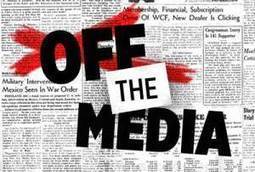 Your new post is loading...
 Your new post is loading...
I have this wall monitor across from my desk that updates the top headlines on Forbes.com every five seconds. I often race up a spiral staircase to the newsroom to congratulate a staff reporter whose post has soared to No.1 To me, it means our journalism has hit home. Then I walk over to our producer desk. They know what I’m going to say: “Make sure you add a gallery to that post — consumers love photos and they drive ad impressions, too.” Next, I’ll peek at four terminals used by a member of our ad sales team — yes, she sits in the newsroom. It’s her job, among many, to optimize advertising campaigns with relevant and spiking content. Everyone in our new newsroom appreciates the imperative to make our premium news product pay off for both the audience and our marketing partners. The business of journalism is changing, requiring every editor and reporter to think and act differently.... [Lewis DVorkin provides a fascinating look inside Forbes. This post is a must-read and should be required reading for all traditional news media executives and journalists too. ~ Jeff]
Dividing the country down the middle, half of U.S. consumers now view over-the-top (OTT) video through broadband connections on their TVs, in addition to the content they traditionally watch via cable or satellite. Consumers are also viewing content on mobile devices, creating video playlists, posting videos on social media, and learning about new TV programs and video offerings through social networks, the consulting firm found. “We are seeing a seismic shift in consumer viewing habits,” said Robin Murdoch, a managing director in Accenture’s Media & Entertainment industry group. “The connected consumer is now comfortable viewing TV shows and video on a variety of screens, as well as sharing opinions of that content via social channels or recommendation engines.”... [The industry better get social very fast ~ Jeff]
The war for the living room will ultimately be won not by gadget manufacturers, but by content companies — the people who make and distribute TV itself. But it’s a two-way street: the... ...internet is changing how even the largest producers of television think about their products. Vivian Schiller has been on the front lines of change for years. She was the first general manager of what has become the Investigation Discovery channel, then the senior vice president of NYTimes.com, and then the CEO of NPR. Now she’s the Chief Digital Officer for NBC News, overseeing the company’s online efforts — including the newly-acquired MSNBC.com, which is now simply NBCnews.com. We spoke about the future of distribution, how Twitter and Facebook are changing NBC’s audience, and the challenges of developing real-time news across different platforms and mediums.... [Good read on media trends- ~ Jeff]
Imagine doing your journalism without any social media. Imagine your newsroom is actually restricted by law in what social media it can use. That was the situation for Austrian radio correspondent Nadja Hahn who has spent the last month at Polis, LSE researching the value of social media for public service journalism. Here is her valedictory post. My stay in London is coming to an end. In the past five weeks I visited the BBC, Channel4, ITV, CNN and spoke to lots of journalists, experts and academics. Thanks to all for sharing their thoughts with me. I had my own personal social media crash course. So, going home now I am thinking about how I could be applying all that knowledge to my own reporting to make my stories better, provide more public value, reach a larger audience and get fresh ideas. I want to share my thoughts with you, as some of you might still be struggling to see the value social media could bring to a story. Like I was.... [Lots of lessons and insight ~ Jeff]
Ben Huh, CEO of online humor destination, Cheezburger, offers his take on why Gene Weingarten’s recent column was wrong about journalism. Journalism still has much to learn about timeliness when an oft-awarded columnist like Gene Weingarten is 34 days late to a story. Journalism still has much to learn about reporting when the writer of the story was actually never present at the event. Journalism still has much to learn about the audience it supposedly serves when it continues to ignore the wants of its readership. It pains me to watch how much obstructionism blocks the progress of some well-meaning journalists, regardless of the humorous nature of Gene’s column....
The Lead Teaser: Roughly eighteen months after the iPad 1 was first introduced, tablets have been described as the fastest-growing new technology ever. How has this new device influenced news consumption habits? Eighteen months after the introduction of the iPad, 11% of U.S. adults now own a tablet computer of some kind. About half (53%) get news on their tablet every day, and they read long articles as well as get headlines. But a majority says they would not be willing to pay for news content on these devices, according to the most detailed study to date of tablet users and how they interact with this new technology....
Pew found that just over a quarter (27%) of adults say they regularly or sometimes get news or news headlines through Facebook, Twitter or other social networking sites. This rises to 38% for younger adults....
Charlie Beckett's post is a must-read... ...That is a very broad brief, but luckily, that is what I spend my time thinking about. I spent 20 years as a traditional TV journalist making documentaries and editing news programmes at the BBC and ITN before setting up Polis, the media think tank at the LSE five years ago. When I joined ITN in 1999 they had one Internet terminal that you had to ask to use. Mobile phones were rationed. Now my iPhone has more computing power than the whole BBC newsroom a decade ago. And remember Moores Law that means computing power doubles every 18 months. So whatever is changing now will probably change again – but quicker. I hope I can use this hour to set out some ideas and a few case studies. I am going to talk mainly about social media in connection with conflict and politics – as that seems most relevant to you – although I am not going to analyse NATO’s media role in particular in any great detail. I think we have a second session where I can respond more precisely to questions from you on how it relates to NATO or your experience in particular.
|
I’ll be the bearer of bad news: the press that most publicists chase for clients isn’t really worth anything. There’s a good chance no one will actually see it. Except the client, that is. The flack will make damn sure of that. But other than that, the assumptions of publicists, clients and journalists—that being featured matters, that being written about will drive awareness or sales or public image—are a collective chimera. The widespread belief is that the media has “reach.” Trust me, they don’t. Not anymore. It’s become almost pathetic. It hit me the other day when I snagged a profile for a client on a well-known website. The day it ran, they editor sent me an email: “Hey, we hate to ask but could you guys be sure to tweet and share the article for us?”... [This is a fascinating article and media irony ~ Jeff]
USA Today is taking advantage of Gannett's custom built CMS system that will let it select and curate content for the growing number of readers who are reading news on mobile devices. Is there a future for a media brand best known for dropping free newspapers at America’s hotels? The brass at USA Today seems to think so and today launched a “next generation” iPad app to carry the brand into the digital future. The app represents a big bet on technology by parent company Gannett which, like other newspaper chains, is on borrowed time as it tries to solve the digital dilemma before its traditional print ad earnings collapse once and for all. The company’s gamble comes in the form of a bespoke content management system that lets editors tailor content specifically for a mobile audience rather than simply slinging content from the USA Today website. In practice, this means shorter and snappier headlines and choosing hard news stories in the morning and then more visual, feature-like fare for later in the day. The move coincides with a mass reader migration to smartphones and tablet devices. “We’re starting to think of these as products that should be actively programmed rather than taking things that were produced for another medium,” said Gannett’s Chief Digital Officer, David Payne.... [This is a fascinating look at how USA Today is trying to shed its newspaper past ~ Jeff]
Dramatic images of hurricane Sandy have made it into the news and have been shared via social media. Farida Vis and Axel Bruns have examined the top 50 most tweeted images and discuss how many of the images shared were actually fake.... [it's a challenging task to verify authenticity of photos, especially in a tragedy Jeff]
Last week, CNN sacked over 50 staffers, many of them camera-lugging photojournalists, in part because it will lean more heavily on its citizen journalism outfit iReport for more, better content. With Monday's relaunch of iReport as a "social network for news," CNN's strategy of shifting various tasks from its paid journalists to the five-year-old network of iReporters is coming into focus. We doubt that CNN will soon replace news anchors with holograms any time soon, but the network is trending towards giving its citizen journalists more assignments, surfacing more of their content on TV and generally making iReport content more of an editorial fixture. And feature-by-feature, there's little doubt that CNN wants the new iReport to be a money-saver as well as a scoop factory....
The wealth of multimedia or social media storytelling tools available can be bewildering for journalists. Often seasoned pros asked me, what is the one thing I should learn and add to my reporting toolkit? To my mind, that’s the right attitude but the wrong question. Journalists need to be open to new ways of telling stories and engaging with audiences. But it is not about adding a new tool to your reporting repertoire. Instead it is about figuring out how to rethink reporting to ensure it remains compelling, relevant and impactful....
...and "the editing process is zero, pretty much."... Great insight into the speed of online publishing.
If journalists don’t stand up to take ownership of this exciting new medium and build great things on it, the engineers and the MBAs will. In the news businesses that will emerge, journalists will continue to remain at the bottom of the Excel sheet of layoff-ability. That is indeed what has been happening, when a lawyer builds the web’s most important technology news site (Michael Arrington – Techcrunch) or two engineers build the most exciting magazine App for tablets and phones (Flipboard). A former equity research analyst edits one of the most popular business news websites (Henry Blodget – Businessinsider). Journalists of the traditional mould don’t quite dictate things in these companies....
|



 Your new post is loading...
Your new post is loading...

















